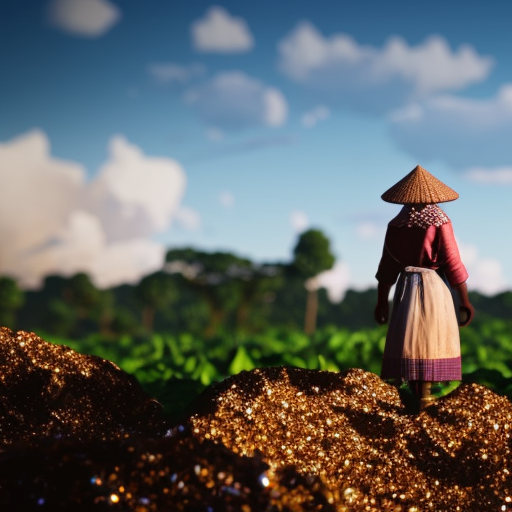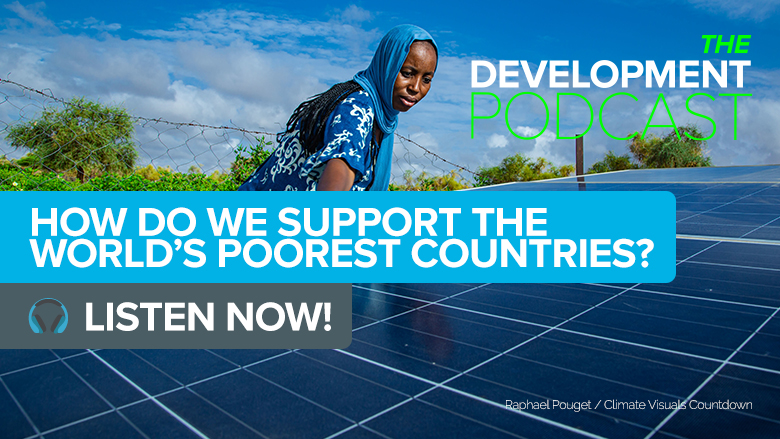
Meet the International Development Association (IDA)
The International Development Association (IDA) is the arm of the World Bank that helps the world’s poorest countries—75 to be exact. It’s the largest single source of donor funds for basic services in these countries and aims to eliminate extreme poverty. IDA’s most recent replenishment, IDA20, resulted in a historic $93 billion financing package for IDA countries for fiscal years 2022-2025.
The Development Podcast: Exploring IDA’s Work
On this episode of The Development Podcast, we explore how IDA works across the world on a range of key development issues and priorities, with the help of some key partners. Join us as we speak with Dirk Reinermann, the World Bank’s Director of Development Finance who oversees IDA, Gregory Chen, Managing Director for the Ultra-Poor Graduation Initiative, within BRAC International, and Maaria Henry, a Fisheries Protection Officer from the Republic of Kiribati in Micronesia, which sits at the forefront of the climate challenge.
Tell us what you think of our podcast here >>>. We would love to hear from you!
Featured Voices
- Dirk Reinermann, Director, IDA Mobilization & IBRD Corporate Finance, World Bank
- Gregory Chen, Managing Director, Ultra-Poor Graduation Initiative, BRAC International
- Maaria Henry, Fisheries Protection Officer from Kiribati

Transcript
[00:00] Raka Banerjee: Hello and welcome to The Development Podcast from the World Bank, coming to you from Washington, DC and beyond. I’m Raka Banerjee.
Srimathi Sridhar: And I’m Srimathi Sridhar. This episode is all about supporting the world’s poorest countries as we face the ongoing challenge of multiple crises.
Raka Banerjee: That’s right. Today we are taking you on a deep dive into a part of the World Bank called IDA, the International Development Association.
Srimathi Sridhar: We’ll be honing in on how IDA works, where and why.
Dirk Reinermann: There’s the climate crisis. We obviously have just lived through a global pandemic. We have food insecurity on the rise. We have lots of debt issues. All of those crises impact the poorest countries, the worst. What we’re doing with IDA is basically responding to those crises and trying to help our countries overcome them.
Raka Banerjee: We’ll also get an insight into some of the partnerships and projects at the heart of the organization from Bangladesh.
Gregory Chen: Bangladesh is in the process of transitioning out of the use of IDA funds 50 plus years on. So development happens.
Srimathi Sridhar: To the shores of a Pacific Island nation. The Republic of Kiribati.
Maaria Henry: Women are not only born to be housewives. For me, I want to encourage all the women out there to get out from their comfort zone, chase their dreams.
Raka Banerjee: All that and more coming up on The Development Podcast from the World Bank.
Srimathi Sridhar: Climate change, pandemics, fragility, food insecurity, these intertwined crises pose significant challenges to the developing world. Low-income countries are particularly vulnerable, and their recovery from COVID-19 has been slow.
Raka Banerjee: That’s right, Sri. And in general, their high levels of debt combined with varying degrees of fragility, makes their populations vulnerable to further shocks, particularly given that their social safety nets are weaker.
Srimathi Sridhar: In a few moments, we’ll dive in and explore what action the World Bank is taking to support the most in need countries and guide you through those three key letters, I, D, A. IDA, short for the International Development Association.
[02:25] Raka Banerjee: But first, let’s get a snapshot of one young woman’s life in the Republic of Kiribati.
Srimathi Sridhar: Kiribati is at the forefront of the climate challenge.
Raka Banerjee: IDA helps to support climate resilience in countries like Kiribati and job prospects too.
Srimathi Sridhar: Our producer, Sarah Treanor found out more.
Sarah Treanor: The sounds of Pacific Ocean waves beating on the shores of the tiny atoll that makes up Tarawa, the capital of Kiribati. The sea both provides islanders with food to consume and sell. Fisheries make up over half of the country’s GDP, but is also the biggest threat to their way of life. The islands are incredibly low-lying and vulnerable to rising sea levels. For young people, particularly women and girls, there can also be a lack of opportunity. But I spoke to one young woman who is leading the way, having studied marine science and now working with the community to ensure responsible use of fish stocks.
Maaria Henry: Hello everyone. My name is Maaria Henry, and I’m from Kiribati. Most of you probably wouldn’t know where and how Kiribati looks like. So Kiribati is one of the least-developing countries in the Pacific, consisting of 33 atolls. I live in the main land called Tarawa, and it has a highest point of three meters above sea level with a population of a 100,000 people. Tarawa and the rest part of the islands are very small and narrow that you can see the ocean and lagoon at almost every places from the main road. You can see people, especially children swimming and men fishing.
From where I live, you can hear men singing on top of the coconut tree in an early morning and the sound of women’s brooms sweeping outside their houses. So it’s always noisy in the mornings. What I love the most about my country is that we are surrounded by the beautiful ocean that provides us with fresh fish every day. When I chose marine science, I felt a bit scared and nervous because a lot of people always tell me that marine science is not a job for women because it involves a lot of diving, farming, and going out to the sea. Sometimes I see myself not fit working for the fishery sector because I’m a woman. That doesn
SDGs, Targets, and Indicators
-
SDG 1: No Poverty
- Target 1.1: By 2030, eradicate extreme poverty for all people everywhere
- Indicator 1.1.1: Proportion of population living below the international poverty line
-
SDG 2: Zero Hunger
- Target 2.1: By 2030, end hunger and ensure access by all people, in particular the poor and people in vulnerable situations, including infants, to safe, nutritious and sufficient food all year round
- Indicator 2.1.2: Prevalence of moderate or severe food insecurity in the population, based on the Food Insecurity Experience Scale (FIES)
-
SDG 5: Gender Equality
- Target 5.5: Ensure women’s full and effective participation and equal opportunities for leadership at all levels of decision-making in political, economic, and public life
- Indicator 5.5.1: Proportion of seats held by women in national parliaments and local governments
-
SDG 13: Climate Action
- Target 13.1: Strengthen resilience and adaptive capacity to climate-related hazards and natural disasters in all countries
- Indicator 13.1.1: Number of deaths, missing persons and directly affected persons attributed to disasters per 100,000 population
-
SDG 16: Peace, Justice and Strong Institutions
- Target 16.6: Develop effective, accountable and transparent institutions at all levels
- Indicator 16.6.1: Primary government expenditures as a proportion of original approved budget, by sector (or by budget codes or similar)
Table: SDGs, Targets, and Indicators
| SDGs | Targets | Indicators |
|---|---|---|
| SDG 1: No Poverty | Target 1.1: By 2030, eradicate extreme poverty for all people everywhere | Indicator 1.1.1: Proportion of population living below the international poverty line |
| SDG 2: Zero Hunger | Target 2.1: By 2030, end hunger and ensure access by all people, in particular the poor and people in vulnerable situations, including infants, to safe, nutritious and sufficient food all year round | Indicator 2.1.2: Prevalence of moderate or severe food insecurity in the population, based on the Food Insecurity Experience Scale (FIES) |
| SDG 5: Gender Equality | Target 5.5: Ensure women’s full and effective participation and equal opportunities for leadership at all levels of decision-making in political, economic, and public life | Indicator 5.5.1: Proportion of seats held by women in national parliaments and local governments |
| SDG 13: Climate Action | Target 13.1: Strengthen resilience and adaptive capacity to climate-related hazards and natural disasters in all countries | Indicator 13.1.1: Number of deaths, missing persons and directly affected persons attributed to disasters per 100,000 population |
| SDG 16: Peace, Justice and Strong Institutions | Target 16.6: Develop effective, accountable and transparent institutions at all levels | Indicator 16.6.1: Primary government expenditures as a proportion of original approved budget, by sector (or by budget codes or similar) |
Analysis
The article addresses several Sustainable Development Goals (SDGs) and their corresponding targets and indicators:
SDG 1: No Poverty
The article highlights the International Development Association’s (IDA) aim to eliminate extreme poverty, which aligns with SDG 1. The specific target mentioned is Target 1.1: By 2030, eradicate extreme poverty for all people everywhere. The indicator that can be used to measure progress towards this target is Indicator 1.1.1: Proportion of population living below the international poverty line.
SDG 2: Zero Hunger
The article mentions IDA’s support for climate resilience and job prospects in countries like Kiribati, which relates to SDG 2. The specific target mentioned is Target 2.1: By 2030, end hunger and ensure access by all people, in particular the poor and people in vulnerable situations, including infants, to safe, nutritious and sufficient food all year round. The indicator that can be used to measure progress towards this target is Indicator 2.1.2: Prevalence of moderate or severe food insecurity in the population, based on the Food Insecurity Experience Scale (FIES).
SDG 5: Gender Equality
The article features Maaria Henry, a Fisheries Protection Officer from Kiribati, who encourages women to pursue their dreams and participate in non-traditional roles. This aligns with SDG 5, which aims to achieve gender equality and empower all women and girls. The specific target mentioned is Target 5.5: Ensure women’s full and effective participation and equal opportunities for leadership at all levels of decision-making in political, economic, and public life. The indicator that can be used to measure progress towards this target is Indicator 5.5.1: Proportion of seats held by women in national parliaments and local governments.
SDG 13: Climate Action
The article highlights Kiribati’s vulnerability to rising sea levels and IDA’s support for climate resilience in countries like Kiribati. This relates to SDG 13, which focuses on taking urgent action to
Behold! This splendid article springs forth from the wellspring of knowledge, shaped by a wondrous proprietary AI technology that delved into a vast ocean of data, illuminating the path towards the Sustainable Development Goals. Remember that all rights are reserved by SDG Investors LLC, empowering us to champion progress together.
Source: worldbank.org

Join us, as fellow seekers of change, on a transformative journey at https://sdgtalks.ai/welcome, where you can become a member and actively contribute to shaping a brighter future.



